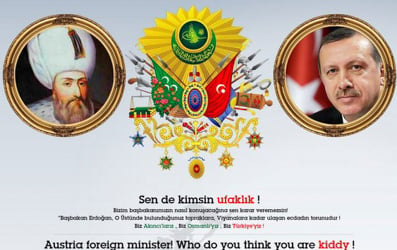The Turkish hacker group, which calls itself Akincilar (Raiders), posted pictures of Erdogan and Sultan Suleiman the Magnificent, one of the most prominent monarchs of the Ottoman Empire, on Kurz's homepage.
They included a text in English, German and Turkish, telling Kurz off for telling the prime minister what to do. They also drew parallels between Erdogan and themselves and the Ottoman Empire.
"Austria foreign minister! Who do you think you are kiddy! You cannot decide how to talk to our prime minister! Erdogan the prime minister is the grandson of ancestors who reached Vienna, the soil you're walking on now! We are Akincilar, We are Ottomans, We are Turkey!"
The empire, which lasted for over 600 years, was dissolved in the aftermath of World War I.
According to Kurz's spokesman Gerald Fleischmann, the foreign minister was unconcerned about the incident. The post was up on the website for three hours on Monday, before it was taken down.
Last week, Kurz called on Erdogan not to make divisive remarks between the Austrian and Turkish communities during his unofficial visit to Austria on Thursday and Friday this week.
Erdogan is due to hold a speech in the Albert-Schulz ice rink in Vienna's 22nd district on Thursday. The rink holds just over 7,000 people.




 Please whitelist us to continue reading.
Please whitelist us to continue reading.
Member comments